The Impact of Urbanization on Surface Runoff and Flood Prevention Strategies: A Case Study of a Traditional Village
Abstract
:1. Introduction
2. Materials and Methods
2.1. Description of the Study Area
2.1.1. Study Area
2.1.2. Changes before and after Reconstruction in the Study Area
2.2. Data Used
2.3. Research Methods
2.3.1. Establishment of the SWMM
2.3.2. Simulation and Analysis of the Changes in Surface Runoff before and after Urbanization Reconstruction
2.3.3. Analysis of the Impact of Reconstruction Activities (Impervious Rate Change) on Surface Runoff
2.3.4. Analysis of the Impact of Reconstruction Activities on Flooding
3. Results
3.1. Changes in Surface Runoff before and after the Reconstruction of Hezhai Village
3.2. Identification of Flooding Points after Reconstruction of Hezhai Village
3.3. The Impact of Impervious Rate Change on Surface Runoff
4. Discussion
4.1. Analysis of the Impact of Urbanization Reconstruction Activities on Surface Runoff Changes in Hezhai Village
4.1.1. Analysis of the Impact of Impervious Rate Change on Surface Runoff
4.1.2. Analysis of the Impact of Urbanization Reconstruction Activities on Flooding
4.2. Suggestions for the Future Reconstruction of Hezhai Village Based on Flood Prevention
4.2.1. Suggestions for the Reconstruction of Flooding Points at 50a in Hezhai Village
4.2.2. Suggestions for the Reconstruction of Ponds and Canals without Flooding but with a High Risk of Future Flooding
4.2.3. Suggestions for the Reconstruction of Ponds and Canals with Low Utilization Rate
5. Conclusions
- The construction and reconstruction activities that have a significant impact on surface runoff in Hezhai Village mainly include the following: 11 ponds have been filled in; 10 ponds have been reduced; 13 channels have been filled in; 14 channels have been narrowed; and the impervious rate of Hezhai Village has increased from 23.88% to 49.60%, representing an increase of 25.72%.
- The surface runoff changed obviously during the rainstorm after the reconstruction of Hezhai Village. According to the SWMM simulation results, for the rainfall return periods of 5a and 50a, the total runoff after the reconstruction increased by 4720 m3 and 5840 m3, respectively, and the peak runoff increased by 3.66 m3/s and 3.97 m3/s, respectively, compared with before the reconstruction. Before the reconstruction, there was no flooding observed at 5a and 50a, but after the reconstruction, the total flooding volume was 697 m3 and 4357 m3, respectively, at 5a and 50a. Regarding flooding points, for the 5a rainfall return period, there are five flooded ponds and two flooded nodes in Hezhai Village. For the 50a rainfall return period, there are nine flooded ponds and five flooded nodes in Hezhai Village.
- Regression analysis of impervious rate with total runoff, peak runoff, and runoff coefficient in 37 sub-catchment areas in Hezhai Village reveals a certain positive correlation between impervious rate and total runoff, an obvious positive correlation between impervious rate and peak runoff, and a significant positive correlation between impervious rate and runoff coefficient. However, the correlation between impervious rate and flooding volume is not obvious.
- This study analyzed the causes of flooding in ponds and ordinary nodes. Pond flooding is mainly determined by the net inflow volume (NI, the difference between inflow and outflow) and the pond capacity (C). When NI exceeds C, the pond begins to flood. Since the ordinary node has almost no water storage capacity, generally speaking, when the Max/Full Depth ratio of the conduit downstream of an ordinary node is less than 1, there will be no flooding at that node. If the Max/Full Depth ratio of the conduit downstream of a node equals 1, it indicates that the node is prone to flooding.
- Based on the analysis of the impact of urbanization reconstruction activities on flooding, this study finds that the increase in the NI of ponds caused by reconstruction activities, such as an increase in impervious pavement, and the decrease in pond capacity caused by pond filling or reduction are the two main causes of the pond flooding in Hezhai Village, and the flooding of ordinary nodes is mainly caused by the full flow of the downstream conduits, which are attributed to two major factors: the increase in inflow and the increase in inflow.
- Suggestions for the future reconstruction of Hezhai Village from the perspective of flood prevention are put forward. To avoid the problem of pond flooding, efforts can be made in two aspects: increasing pond capacity and reducing net inflow. For the flooding issues at several ordinary nodes, solutions can include restoring landfilled water canals, and widening the width and deepening the depth of the downstream canals. For ponds in Hezhai Village where there is no flooding but a high risk of flooding, it is recommended that ponds with a Maximum Percent Full ratio exceeding 80% should not be reduced in size and should ideally be appropriately expanded to avoid flooding during high-intensity rainstorms. Indeed, the figure of 80% is merely a rough, operational convenience-oriented standard value. When it comes to the actual reconstruction of the village, specific reconstruction methods and measures must be determined through comprehensive analysis based on the SWMM simulation. As for the ponds and canals in Hezhai Village with low utilization rates and relatively small roles in stormwater management, it is considered that they can be appropriately reduced or even landfilled in the process of village reconstruction.
Author Contributions
Funding
Data Availability Statement
Acknowledgments
Conflicts of Interest
References
- Yang, B.; Zhang, T.; Li, J.; Feng, P.; Miao, Y. Optimal designs of LID based on LID experiments and SWMM for a small-scale community in Tianjin, north China. J. Environ. Manag. 2023, 334, 117442. [Google Scholar] [CrossRef] [PubMed]
- Qin, H.P.; Li, Z.X.; Fu, G. The effects of low impact development on urban flooding under different rainfall characteristics. J. Environ. Manag. 2013, 129, 577–585. [Google Scholar] [CrossRef] [PubMed]
- Guan, M.; Sillanpää, N.; Koivusalo, H. Modelling and assessment of hydrological changes in a developing urban catchment. Hydrol. Process 2015, 29, 2880–2894. [Google Scholar] [CrossRef]
- Shuster, W.D.; Bonta, J.; Thurston, H.; Warnemuende, E.; Smith, D.R. Impacts of impervious surface on watershed hydrology: A review. Urban. Water J. 2005, 2, 263–275. [Google Scholar] [CrossRef]
- Dietz, M.E.; Clausen, J.C. Stormwater runoff and export changes with development in a traditional and low impact subdivision. J. Environ. Manag. 2008, 87, 560–566. [Google Scholar] [CrossRef]
- Jinkang, D.; Li, Q.; Hanyi, R.; Tianhui, Z.; Dapeng, Z.; Youpeng, X.; Xu, C.Y. Assessing the effects of urbanization on annual runoff and flood events using an integrated hydrological modeling system for Qinhuai River basin, China. J. Hydrol. 2012, 464–465, 127–139. [Google Scholar]
- San Liew, Y.; Desa, S.M.; Noh, M.N.M.; Tan, M.L.; Zakaria, N.A.; Chang, C.K. Assessing the Effectiveness of Mitigation Strategies for Flood Risk Reduction in the Segamat River Basin, Malaysia. Sustainability 2021, 13, 3286. [Google Scholar] [CrossRef]
- Ekmekcioğlu, Ö.; Yılmaz, M.; Özger, M.; Tosunoğlu, F. Investigation of the low impact development strategies for highly urbanized area via auto-calibrated Storm Water Management Model (SWMM). Water Sci. Technol. 2021, 84, 2194–2213. [Google Scholar] [CrossRef]
- Li, J.; Zhou, W.; Tao, C. The Value of Traditional Ecological Knowledge in Stormwater Management: A Case Study of a Traditional Village. Land 2024, 13, 242. [Google Scholar] [CrossRef]
- Zhang, H. Rural Pond Landscape Design in Zhejiang under the background of New Rural Construction. Master’s Thesis, Shanghai Normal University, Shanghai, China, 2019. [Google Scholar]
- Liu, H.; Gu, X. Water Ecological Wisdom and Practice of Traditional Village: Inspiration from Liukeng Village in Fuzhou, Jiangxi for Rural Revitalization. Ecol. Environ. Monit. Three Gorges 2018, 3, 51–58. [Google Scholar]
- Zhou, C.; Cao, P. Contribution and Enlightenment of Ancient Chinese Landscape Architecture and Rainwater Management—Taking Beijing Yuquan Water System as the Example. Chin. Landsc. Archit. 2017, 33, 114–118. [Google Scholar]
- Miller, J.D.; Hutchins, M. The impacts of urbanisation and climate change on urban flooding and urban water quality: A review of the evidence concerning the United Kingdom. J. Hydrology. Reg. Stud. 2017, 12, 345–362. [Google Scholar] [CrossRef]
- Lin, Z.; Xu, Y.; Dai, X.; Wang, Q.; Gao, B.; Xiang, J.; Yuan, J. Changes in the plain river system and its hydrological characteristics under urbanization—Case study of Suzhou City, China. Hydrol. Sci. J. 2019, 64, 2068–2079. [Google Scholar] [CrossRef]
- Jankowfsky, S.; Branger, F.; Braud, I.; Rodriguez, F.; Debionne, S.; Viallet, P. Assessing anthropogenic influence on the hydrology of small peri-urban catchments: Development of the object-oriented PUMMA model by integrating urban and rural hydrological models. J. Hydrol. 2014, 517, 1056–1071. [Google Scholar] [CrossRef]
- Atharinafi, Z.; Wijaya, N. Land Use Change and Its Impacts on Surface Runoff in Rural Areas of the Upper Citarum Watershed (Case Study: Cirasea Sub-watershed). J. Reg. City Plan. 2021, 32, 36–55. [Google Scholar] [CrossRef]
- Jiang, Y.; Zhang, S. Influence of urbanization on hydrologic cycle and countermeasures. Water Sci. Eng. Technol. 2010, 06, 30–32. [Google Scholar]
- Paul, M.J.; Meyer, J.L. Streams in the urban landscape. Annu. Rev. Ecol. Evol. Syst. 2001, 32, 333–365. [Google Scholar] [CrossRef]
- Li, S.; Huang, T. Influence on Rainfall Run-off due to Urbanization and Rain-water Flood Control in the City. China Munic. Eng. 2002, 99, 35–37. [Google Scholar]
- Babaei, S.; Ghazavi, R.; Erfanian, M. Urban flood simulation and prioritization of critical urban sub-catchments using SWMM model and PROMETHEE II approach. Phys. Chem. Earth. Parts A/B/C 2018, 105, 3–11. [Google Scholar] [CrossRef]
- Gautam, K.; Corzo, G. Evaluating the impact of ponds on flood and drought mitigation in the Bagmati River Basin, Nepal. Hydrol. Res. 2023, 54, 1163–1180. [Google Scholar] [CrossRef]
- Yazdi, J. Optimal Operation of Urban Storm Detention Ponds for Flood Management. Water Resour. Manag. 2019, 33, 2109–2121. [Google Scholar] [CrossRef]
- Birkinshaw, S.J.; Krivtsov, V. Evaluating the Effect of the Location and Design of Retention Ponds on Flooding in a Peri-Urban River Catchment. Land 2022, 11, 1368. [Google Scholar] [CrossRef]
- Ayalew, T.B.; Krajewski, W.F.; Mantilla, R. Insights into Expected Changes in Regulated Flood Frequencies due to the Spatial Configuration of Flood Retention Ponds. J. Hydrol. Eng. 2015, 20, 4015010. [Google Scholar] [CrossRef]
- Ferk, M.; Ciglič, R.; Komac, B.; Loczy, D. Management of small retention ponds and their impact on flood hazard prevention in the Slovenske Gorice Hills. Acta Geogr. Slov. 2020, 60, 107–125. [Google Scholar] [CrossRef]
- Tseng, K.; Yang, T.; Chen, P.; Chien, H.; Chen, C.; Hung, Y. Exploring the Feasibility of Mitigating Flood Hazards by an Existing Pond System in Taoyuan, Taiwan. Drones 2023, 7, 1. [Google Scholar] [CrossRef]
- Napoli, M.; Massetti, L.; Orlandini, S. Hydrological response to land use and climate changes in a rural hilly basin in Italy. Catena 2017, 157, 1–11. [Google Scholar] [CrossRef]
- Hasenmueller, E.A.; Criss, R.E.; Winston, W.E.; Shaughnessy, A.R.; Lyons, W.B.; Gardner, C.B.; Long, D.T. Stream hydrology and geochemistry along a rural to urban land use gradient. Appl. Geochem. 2017, 83, 136–149. [Google Scholar] [CrossRef]
- Wang, J. Research on the Renovation Design of Village Environment Reconstruction in Scenic Spot: Taking the Scenic Spot of Qing Yazhai Reserve as an Example. Master’s Thesis, Xi’an University of Architecture and Technology, Xi’an, China, 2019. [Google Scholar]
- Li, S. Research on Renewal Planning of Traditional Villages in Taihang Mountain Area under the Concept of Low Impact Development. Master’s Thesis, China University of Mining and Technology, Xuzhou, China, 2022. [Google Scholar]
- Palla, A.; Gnecco, I. Hydrologic modeling of low impact development systems at the urban catchment scale. J. Hydrol. 2015, 528, 361–368. [Google Scholar] [CrossRef]
- Yiwu local Chronicles Compilation Committee. Yiwu Yearbook 2022; Fangzhi Publishing House: Beijing, China, 2022. [Google Scholar]
- Rossman, L.; Simon, M. Storm Water Management Model User’s Manual Version 5.2; EPA/600/R-22/030; U.S. Environmental Protection Agency: Washington, DC, USA, 2022.
- Rossman, L.A.; Huber, W.C. Storm Water Management Model Reference Manual Volume I—Hydrology (Revised); National Risk Management Laboratory, U.S. Environmental Protection Agency: Cincinnati, OH, USA, 2016.
- Campbell, C.W.; Sullivan, S.M. Simulating time-varying cave flow and water levels using the Storm Water Management Model. Eng. Geol. 2002, 65, 133–139. [Google Scholar] [CrossRef]
- Li, J.; Li, Y.; Li, Y. SWMM-based evaluation of the effect of rain gardens on urbanized areas. Environ. Earth Sci. 2016, 75, 17. [Google Scholar] [CrossRef]
- Xu, T.; Jia, H.; Wang, Z.; Mao, X.; Xu, C. SWMM-based methodology for block-scale LID-BMPs planning based on site-scale multi-objective optimization: A case study in Tianjin. Front. Environ. Sci. Eng. 2017, 11, 1. [Google Scholar] [CrossRef]
- GB 50014-2021; Ministry of Housing and Urban-Rural Development of the People’s Republic of China Standard for Design of Outdoor Wastewater Engineering. China Planning Press: Beijing, China, 2021.
- Xie, J.; Wu, C.; Li, H.; Chen, G. Study on Storm-Water Management of Grassed Swales and Permeable Pavement Based on SWMM. Water 2017, 9, 840. [Google Scholar] [CrossRef]
- Yang, Y.; Li, J.; Huang, Q.; Xia, J.; Li, J.; Liu, D.; Tan, Q. Performance assessment of sponge city infrastructure on stormwater outflows using isochrone and SWMM models. J. Hydrol. 2021, 597, 126151. [Google Scholar] [CrossRef]
- Zhejiang Provincial Department of Housing and Urban-Rural Development. Calculation Criteria of Rainstorm Intensity; China Statistics Press: Beijing, China, 2020.
- Rossman, L.A.; Huber, W.C. Storm Water Management Model Reference Manual Volume II—Hydraulics; National Risk Management Laboratory, U.S. Environmental Protection Agency: Cincinnati, OH, USA, 2017.
- Liu, X. Parameter calibration method for urban rainfall-runoff model based on runoff coefficient. Water Wastewater Eng. 2009, 35, 213–217. [Google Scholar]
- Li, Y.; Ye, S.S.; Wu, Q.Z. Analysis and countermeasures of the “7.20” flood in Zhengzhou. J. Asian Arch. Build. 2023, 22, 3782–3798. [Google Scholar] [CrossRef]
- Beijing Municipal Design and Research Institute. Concise Drainage Design Manual; China Architecture & Building Press: Beijing, China, 1990. [Google Scholar]
- Wang, L.; Zhang, J.; Wang, X. Simulation analysis of rain and flood control of permeable pavementbased on LID theory. Water Resour. Dev. Manag. 2022, 8, 48–54. [Google Scholar]
- Li, H. Investigation of Highway Stormwater Management Pond Capacity for Flood Detention and Water Quality Treatment Retention via Remote Sensing Data and Conventional Topographic Survey. Transp. Res. Rec. 2020, 2674, 514–527. [Google Scholar] [CrossRef]
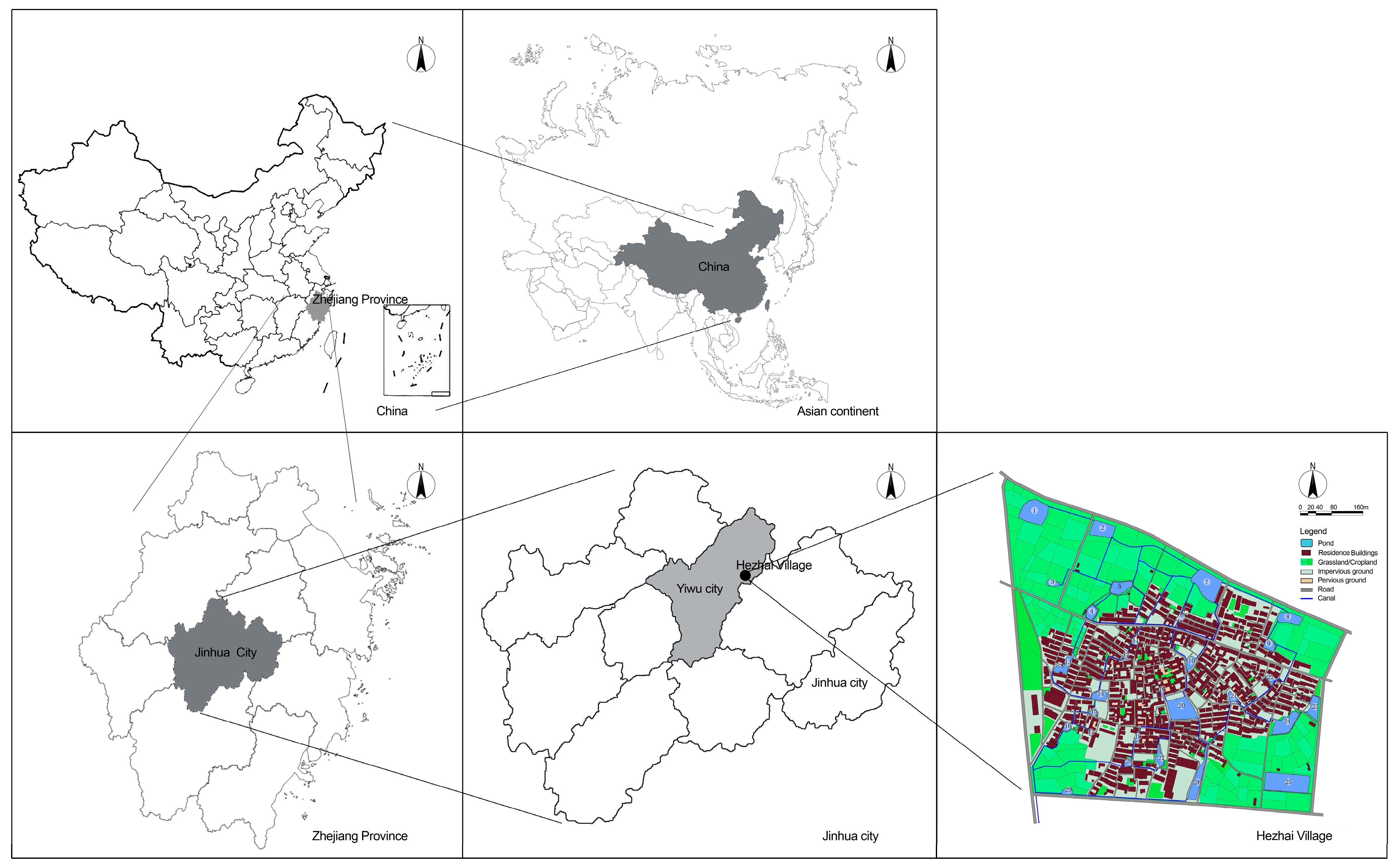

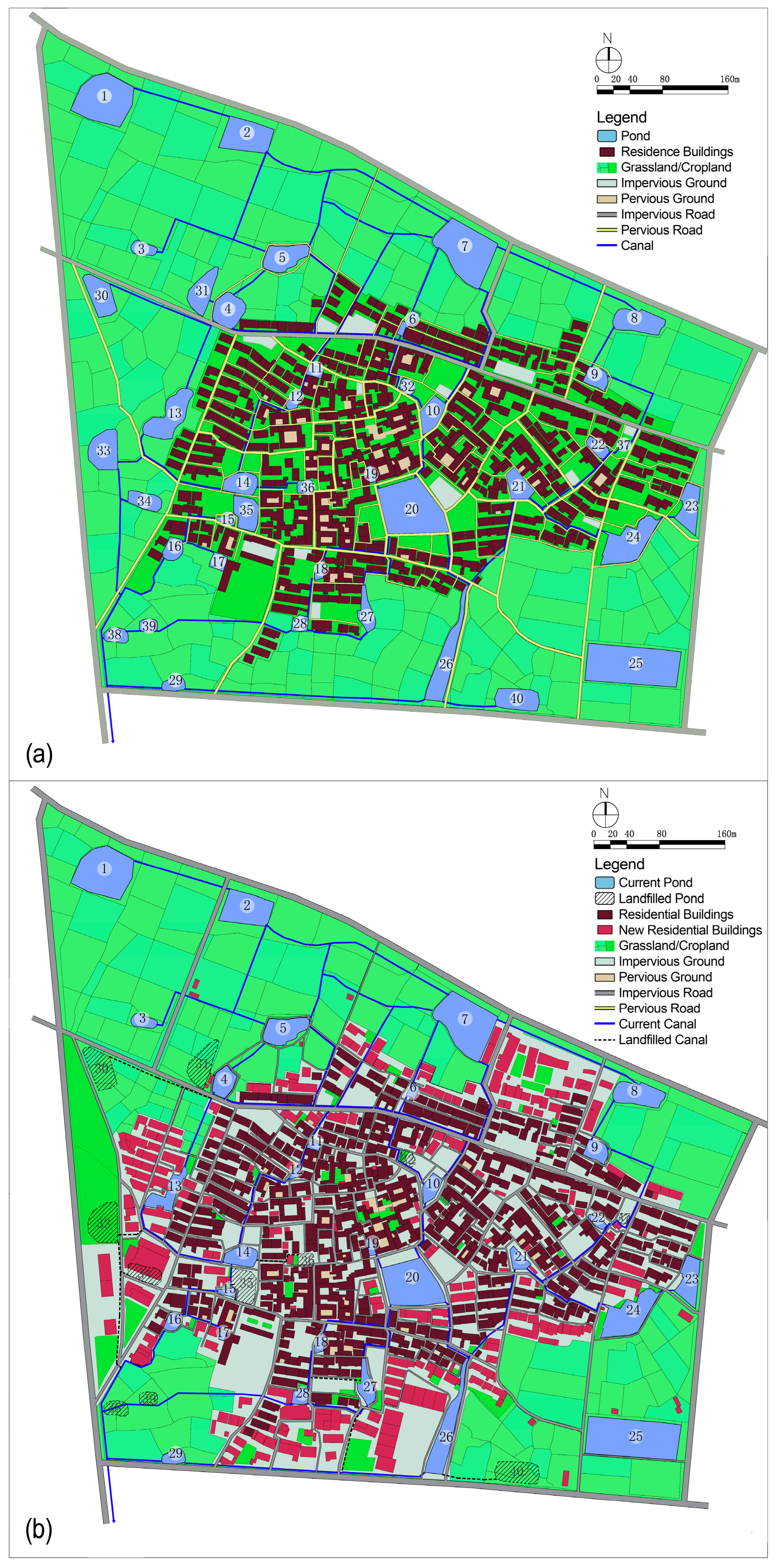
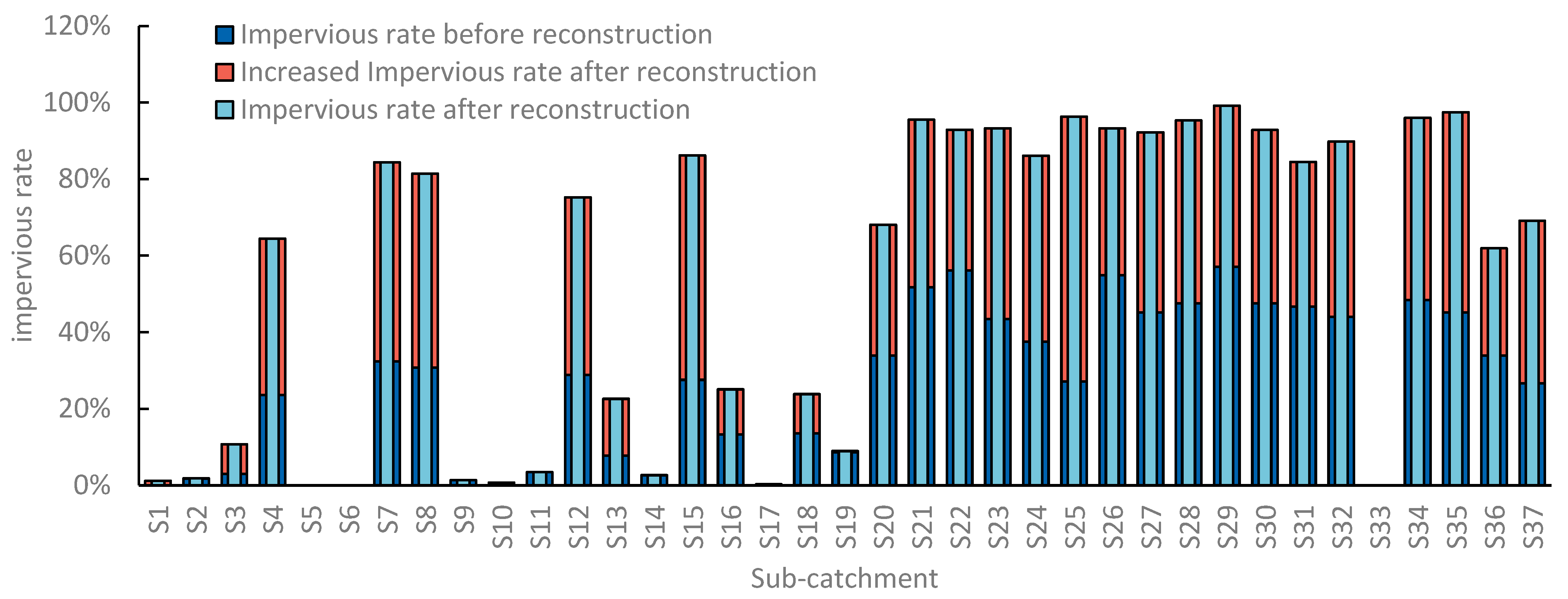
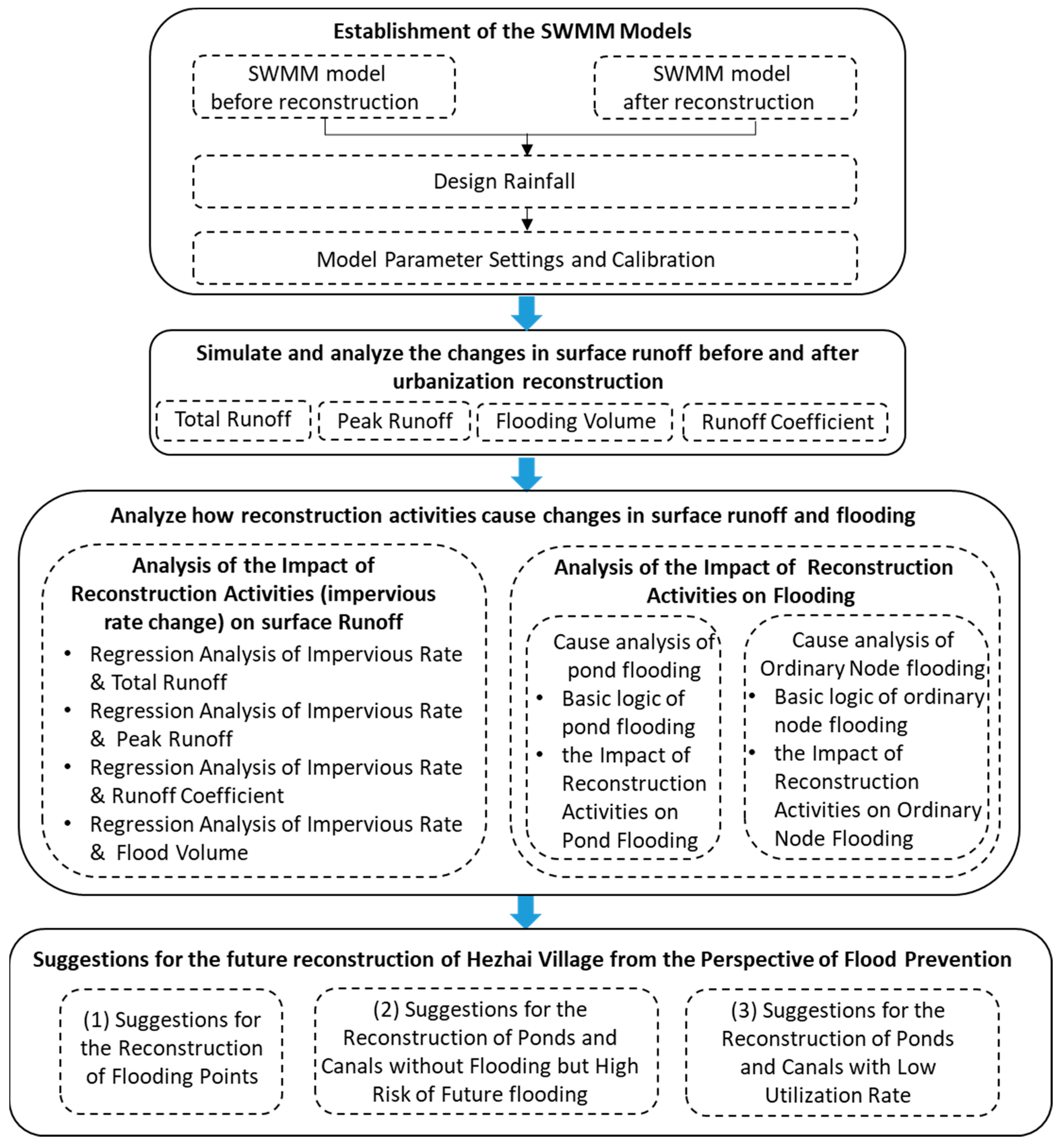

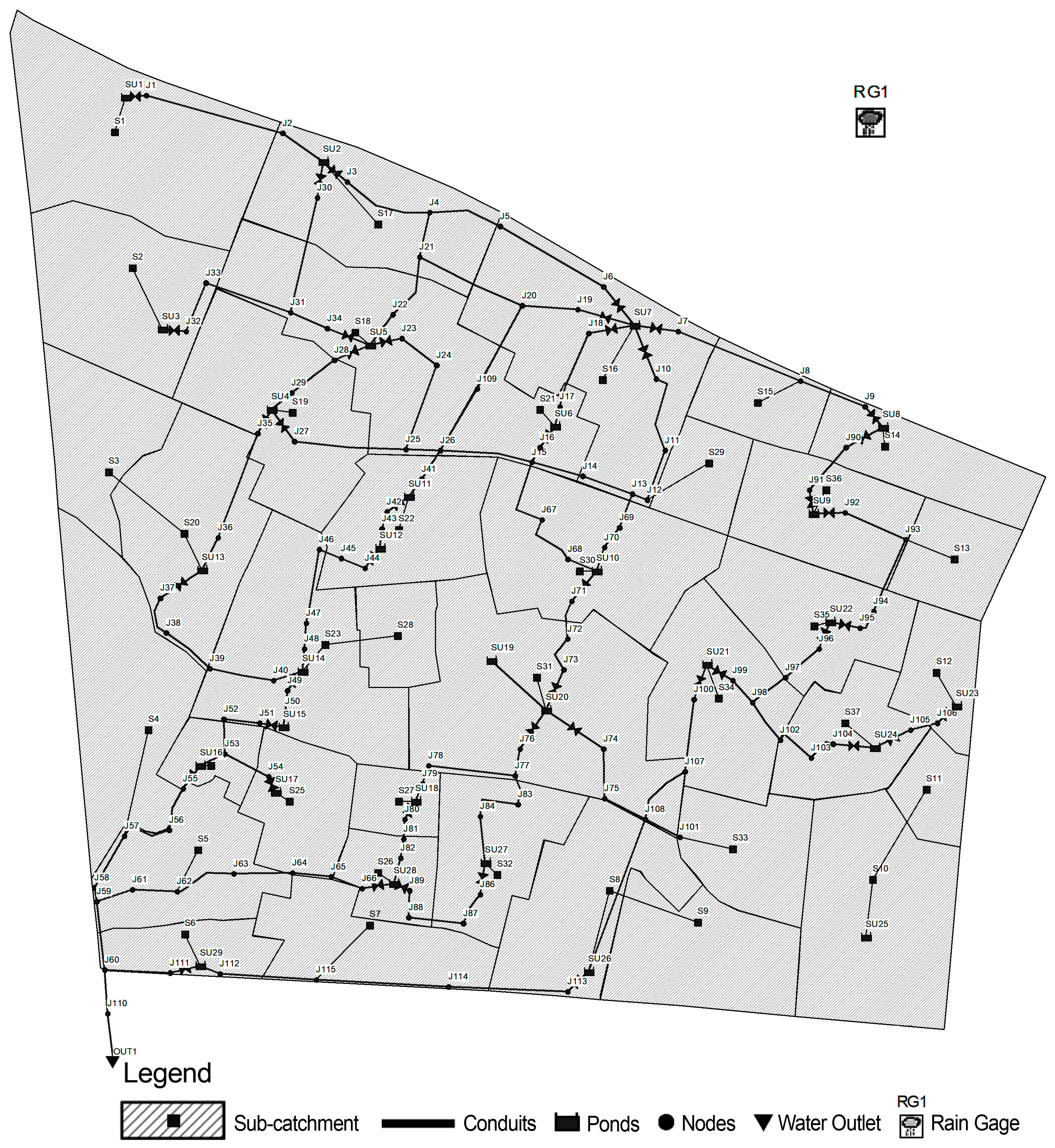


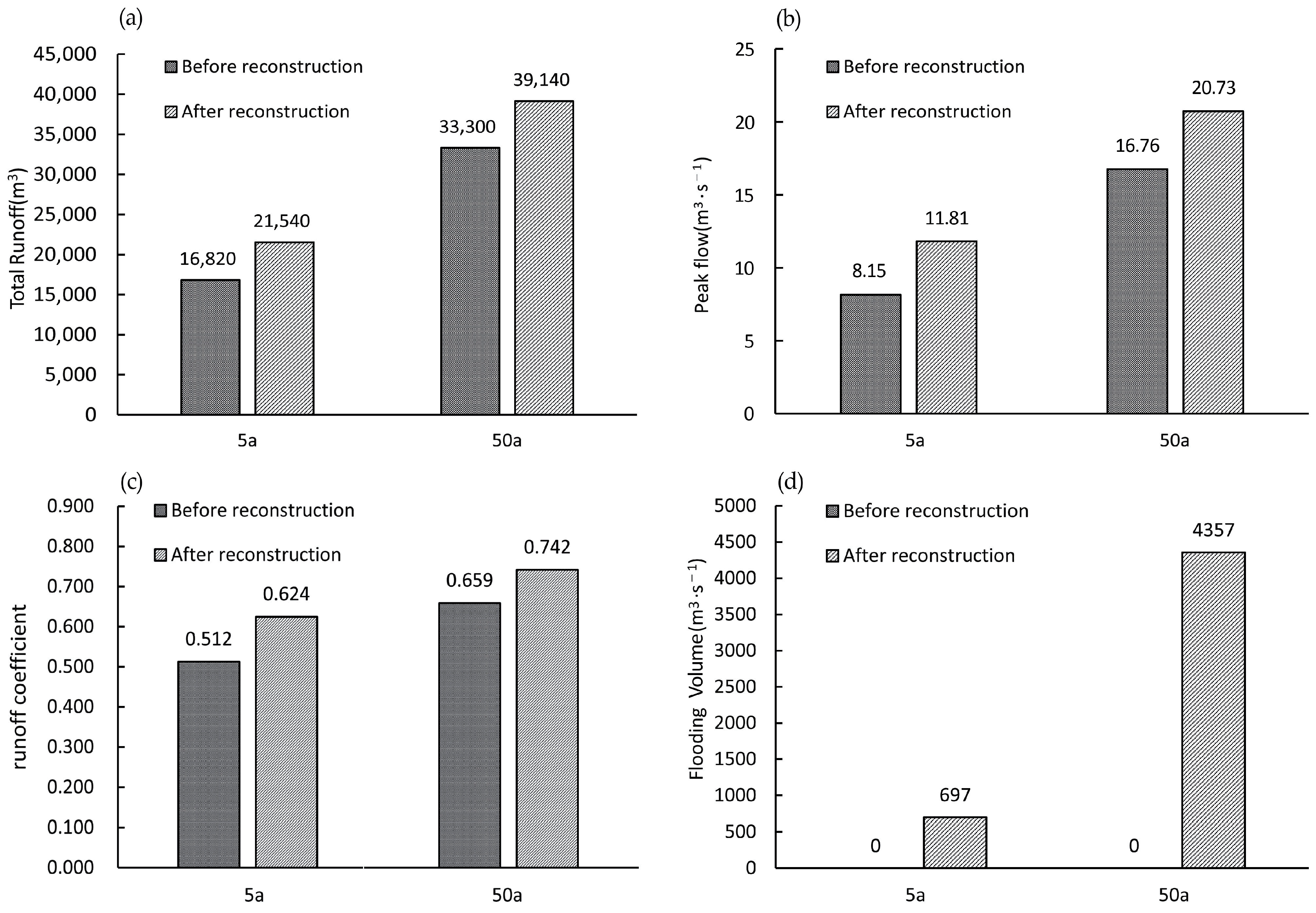
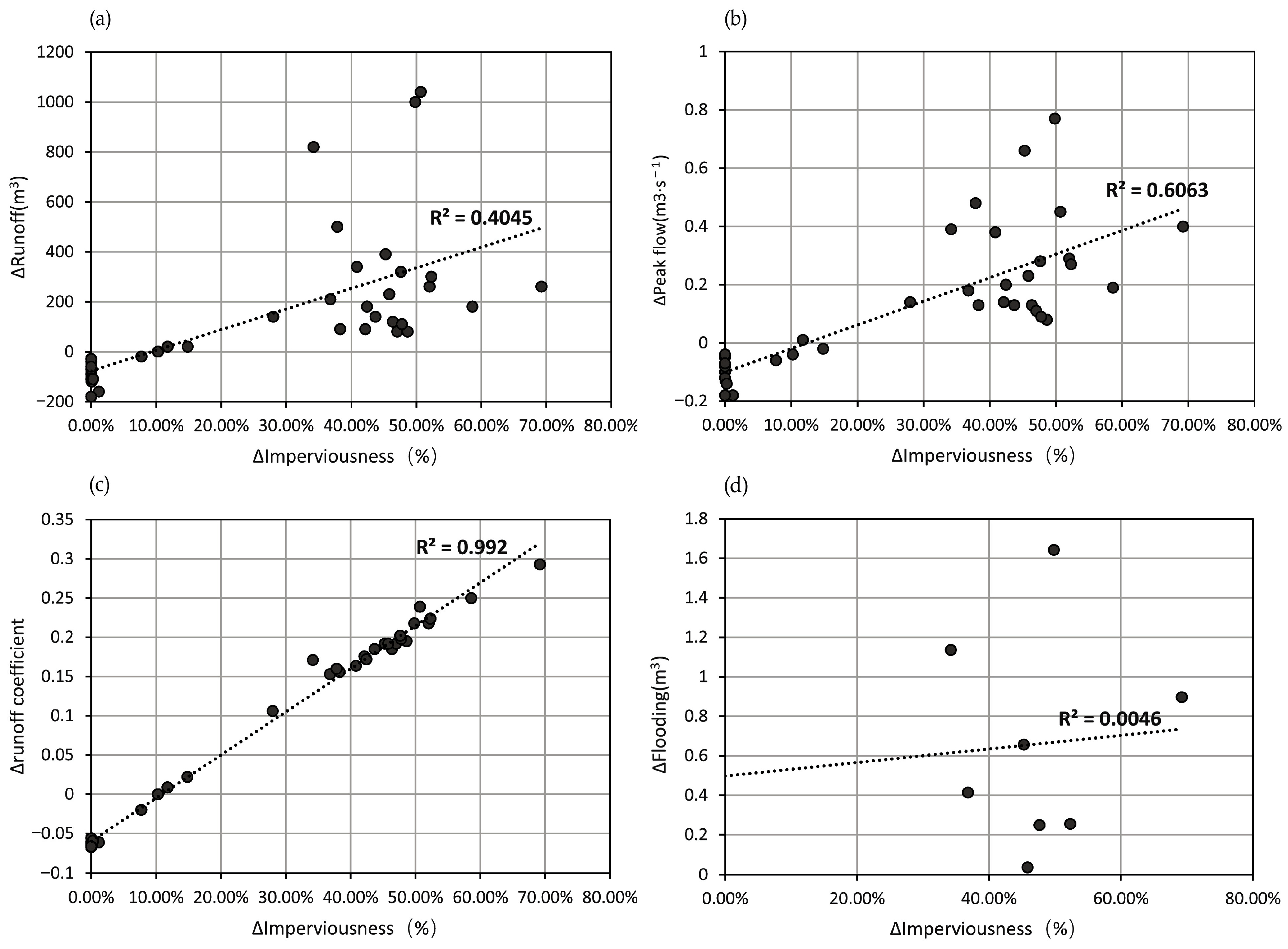
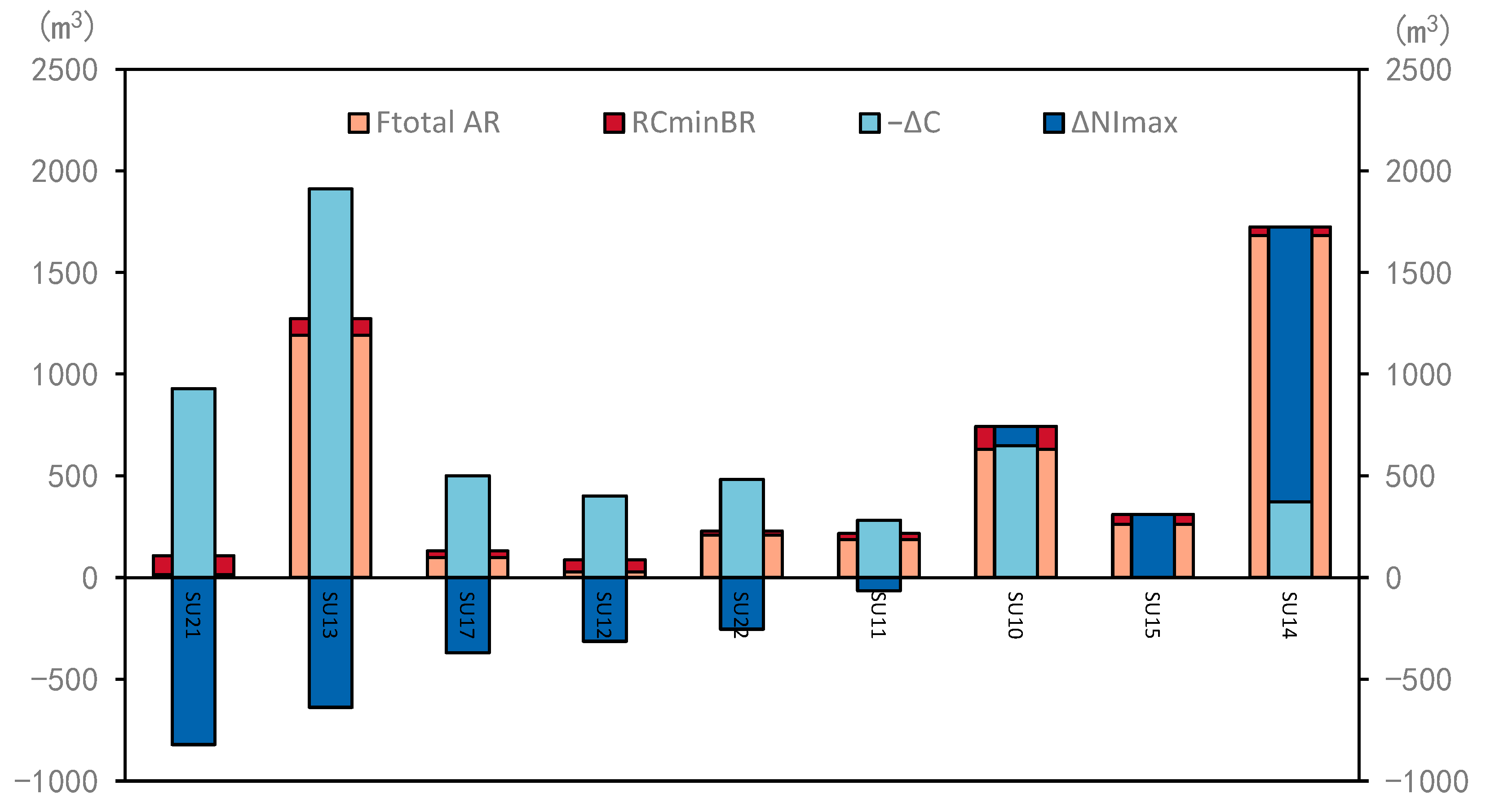
| Parameter | Initial Value |
|---|---|
| N-Impervious | 0.012 |
| N-Pervious | 0.3 |
| Dstore-Impervious | 1.5 |
| Dstore-Pervious | 3.8 |
| Max. Infil. Rate (mm/h) | 76.2 |
| Min. Infil. Rate (mm/h) | 5 |
| Decay Constant (1/h) | 3 |
| Drying Time (day) | 7 |
| N-Conduit | 0.015 |
| Area Situation | Comprehensive Runoff Coefficient |
|---|---|
| areas with densest buildings (impervious area rate ≥ 70%) | 0.6~0.8 |
| areas with denser buildings (impervious area rate 50~70%) | 0.5~0.7 |
| areas with sparser buildings (impervious area rate 30~50%) | 0.4~0.6 |
| areas with sparsest buildings (impervious area rate ≤ 30%) | 0.3~0.5 |
| Type | Parameter | Unit | Parameter Calibration Result of the Model before Reconstruction | Parameter Calibration Result of the Model after Reconstruction |
|---|---|---|---|---|
| Sub-catchment parameters | N-Impervious | / | 0.014 | 0.014 |
| N-Pervious | / | 0.11 | 0.15 | |
| Dstore-Impervious | mm | 1.2 | 1.2 | |
| Dstore-Pervious | mm | 2.5 | 7.4 | |
| Max. Infil. Rate (mm/h) | mm/h | 72 | 72 | |
| Min. Infil. Rate (mm/h) | mm/h | 5 | 5 | |
| Decay Constant (1/h) | 1/h | 2.10 | 2.10 | |
| Drying Time (day) | day | 7 | 7 | |
| Conduit parameters | N-Conduit | / | 0.015 | 0.015 |
| 50a | flooding nodes | J37 | J38 | J39 | J87 | J99 | SU10 | SU11 | SU12 | SU13 | SU14 | SU15 | SU17 | SU21 | SU22 |
| flood volume (m3) | 12.0 | 17.0 | 16.0 | 36.0 | 179.0 | 657.0 | 181.0 | 32.0 | 1134.0 | 1533.0 | 267.0 | 96.0 | 2.0 | 230.0 | |
| 5a | flooding nodes | / | J38 | J39 | / | SU10 | / | SU12 | / | SU14 | SU15 | SU17 | / | / | |
| flood volume (m3) | / | 1.0 | 1.0 | / | 76.0 | / | 7.0 | / | 432.0 | 153.0 | 11.0 | / | / |
| Rainfall Scenario | Rainfall Intensity | Flooding Nodes | |||||||
|---|---|---|---|---|---|---|---|---|---|
| simulation scenario at 5a | 58.32 (mm/h) | SU10 | SU12 | SU14 | SU15 | SU17 | J38 | J39 | / |
| actual rainfall scenario on June 23, 2023 | 54.65 (mm/h) | SU10 | / | SU14 | SU15 | SU17 | J38 | J39 | J37 |
| Flooded Node Label | Flooding Volume(m3) | Downstream Conduit | Max/Full Depth Ratio of Conduit BR | Max/Full Depth Ratio of Conduit AR |
|---|---|---|---|---|
| J37 | 12.0 | C43 | 0.66 | 1 |
| J38 | 17.0 | C44 | 0.62 | 1 |
| J39 | 16.0 | C45 | 0.83 | 1 |
| J87 | 36.0 | C86 | 0.58 | 1 |
| J98 | 179.0 | C9 | 0.90 | 1 |
| Flooded Node Label | Flooding Volume (m3) | Causes of Flooding | ||||
|---|---|---|---|---|---|---|
| Pond Landfill | Pond Shrink | Conduit Landfill | Conduit Narrow | Impervious Rate Increases | ||
| J37 | 12.0 | / | Upstream pond SU13’s capacity decreased by 1910.67 m3 | Diversion conduits C116-C119 downstream of J38 were all landfilled | / | The impervious rate of the S20 catchment area increased by 34.18% |
| J38 | 17.0 | / | Same as above | Same as above | / | Same as above |
| J39 | 16.0 | / | Same as above | Same as above | / | Same as above |
| J87 | 36.0 | / | / | Diversion conduit C2 downstream of J87 was landfilled | / | The impervious rate of the S32 catchment area where J87 is located increased by 45.82% |
| J98 | 179.0 | / | / | / | The width of C9 downstream of J98 is reduced from 1.2 m to 0.8 m | The impervious rate of the S34 catchment area where J98 is located increased by 47.63% |
| SU10 | 657.0 | / | The capacity of pond SU10 is reduced | / | / | The impervious rate of the S30 catchment area where SU20 is located increased by 45.27% |
| SU11 | 181.0 | / | The capacity of pond SU11 is reduced | / | / | / |
| SU12 | 32.0 | / | The capacity of pond SU12 is reduced | / | / | / |
| SU13 | 1134.0 | / | The capacity of pond SU13 is reduced | / | / | / |
| SU14 | 1533.0 | / | The capacity of pond SU14 is reduced | Due to the landfill of conduits C116-C119, the inflow of SU14 from J40 increased by 3050 m3 | / | The impervious rate of the S23 catchment area where SU14 is located increased by 49.81% |
| SU15 | 267.0 | The landfill of SU35 upstream of SU15 resulted in a decrease of 738.3 m3 in rainwater storage, which in turn resulted in an increase of 3790 m3 in the inflow of SU15 from the upstream conduit | / | / | / | The impervious rate of the S23 catchment area where SU15 is located increased by 49.81% |
| SU17 | 96.0 | / | The capacity of pond SU17 is reduced | / | / | / |
| SU21 | 2.0 | / | The capacity of pond SU21 is reduced | / | / | / |
| SU22 | 230.0 | / | The capacity of pond SU22 is reduced | / | / | / |
Disclaimer/Publisher’s Note: The statements, opinions and data contained in all publications are solely those of the individual author(s) and contributor(s) and not of MDPI and/or the editor(s). MDPI and/or the editor(s) disclaim responsibility for any injury to people or property resulting from any ideas, methods, instructions or products referred to in the content. |
© 2024 by the authors. Licensee MDPI, Basel, Switzerland. This article is an open access article distributed under the terms and conditions of the Creative Commons Attribution (CC BY) license (https://creativecommons.org/licenses/by/4.0/).
Share and Cite
Li, J.; Zhou, W.; Tao, C. The Impact of Urbanization on Surface Runoff and Flood Prevention Strategies: A Case Study of a Traditional Village. Land 2024, 13, 1528. https://doi.org/10.3390/land13091528
Li J, Zhou W, Tao C. The Impact of Urbanization on Surface Runoff and Flood Prevention Strategies: A Case Study of a Traditional Village. Land. 2024; 13(9):1528. https://doi.org/10.3390/land13091528
Chicago/Turabian StyleLi, Jiaxin, Wuzhong Zhou, and Cong Tao. 2024. "The Impact of Urbanization on Surface Runoff and Flood Prevention Strategies: A Case Study of a Traditional Village" Land 13, no. 9: 1528. https://doi.org/10.3390/land13091528





